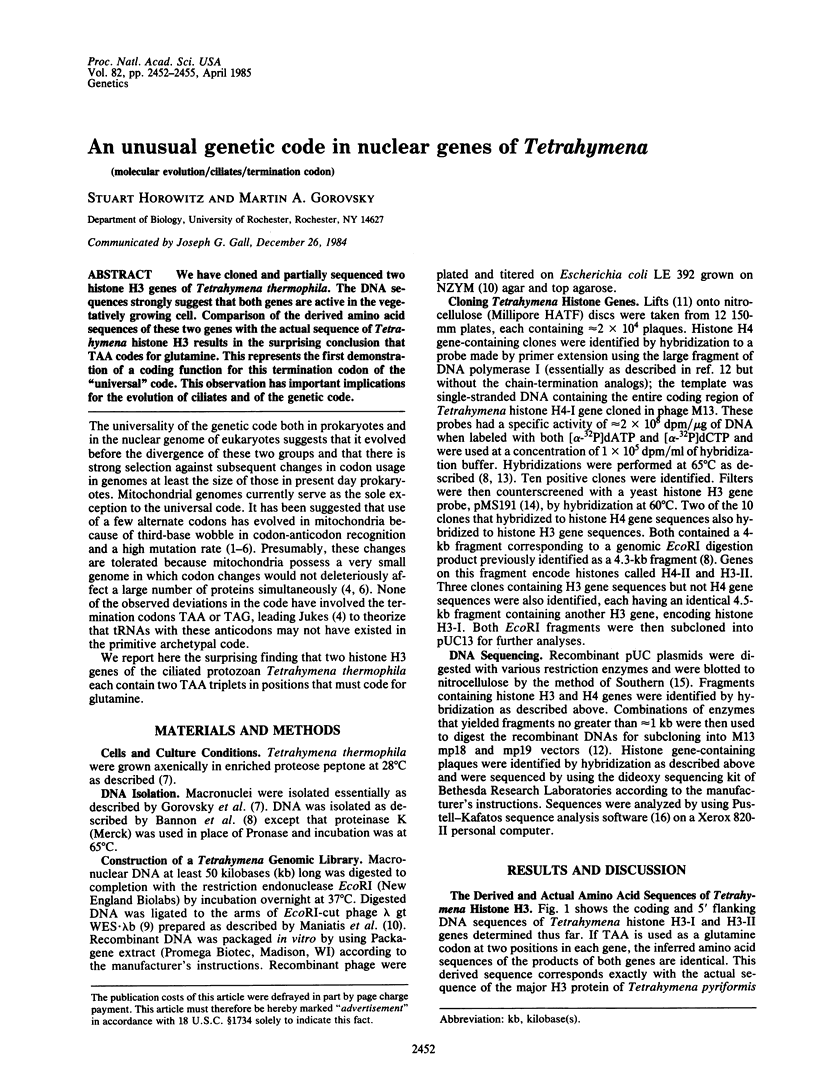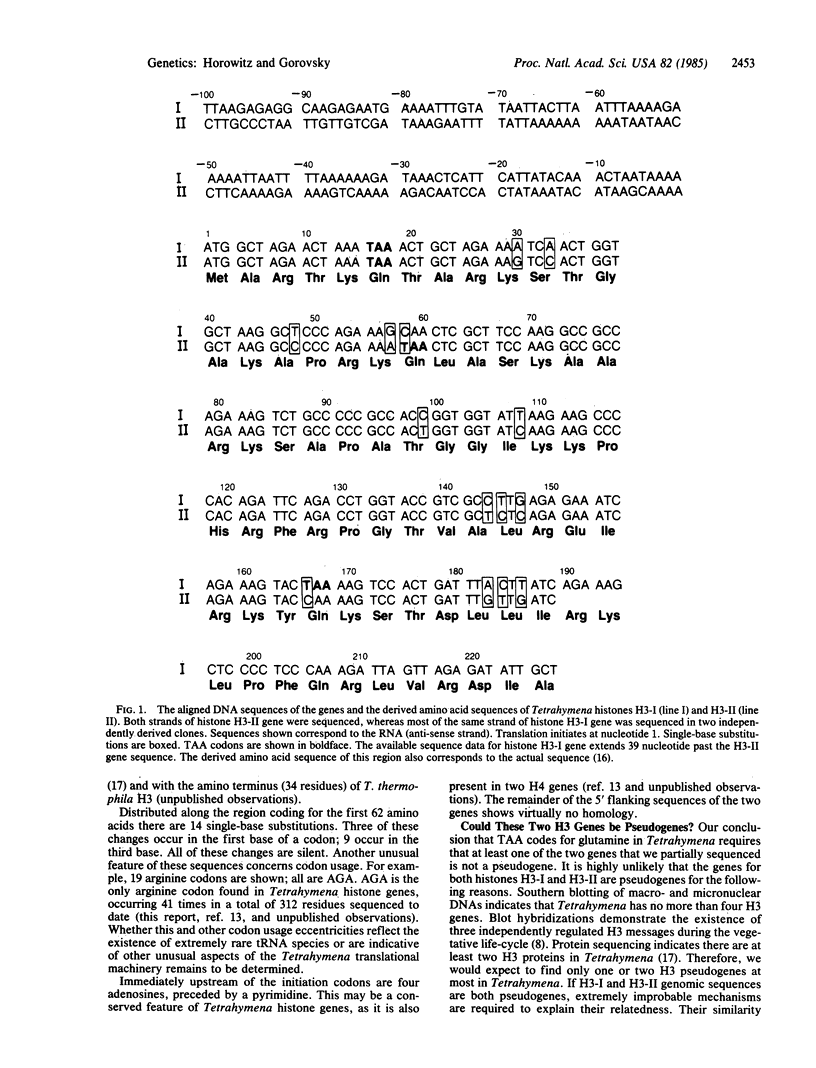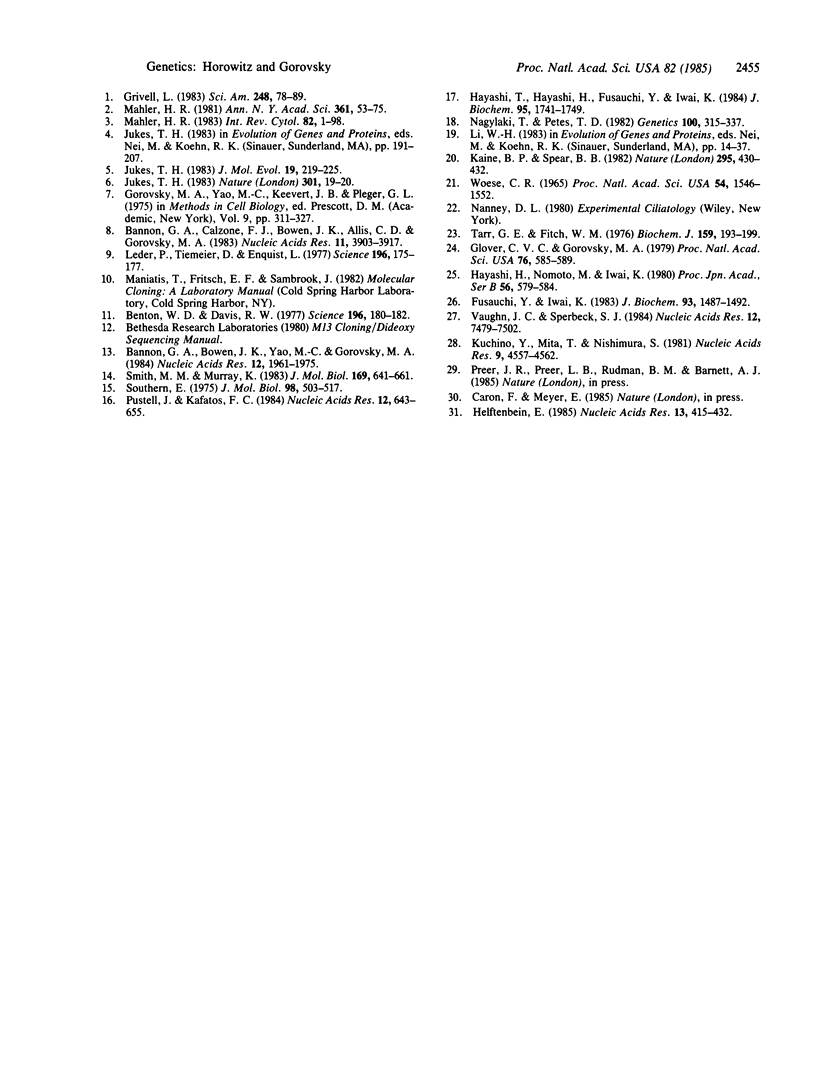Abstract
We have cloned and partially sequenced two histone H3 genes of Tetrahymena thermophila. The DNA sequences strongly suggest that both genes are active in the vegetatively growing cell. Comparison of the derived amino acid sequences of these two genes with the actual sequence of Tetrahymena histone H3 results in the surprising conclusion that TAA codes for glutamine. This represents the first demonstration of a coding function for this termination codon of the "universal" code. This observation has important implications for the evolution of ciliates and of the genetic code.
Full text
PDF



Selected References
These references are in PubMed. This may not be the complete list of references from this article.
- Bannon G. A., Bowen J. K., Yao M. C., Gorovsky M. A. Tetrahymena H4 genes: structure, evolution and organization in macro- and micronuclei. Nucleic Acids Res. 1984 Feb 24;12(4):1961–1975. doi: 10.1093/nar/12.4.1961. [DOI] [PMC free article] [PubMed] [Google Scholar]
- Bannon G. A., Calzone F. J., Bowen J. K., Allis C. D., Gorovsky M. A. Multiple, independently regulated, polyadenylated messages for histone H3 and H4 in Tetrahymena. Nucleic Acids Res. 1983 Jun 25;11(12):3903–3917. doi: 10.1093/nar/11.12.3903. [DOI] [PMC free article] [PubMed] [Google Scholar]
- Benton W. D., Davis R. W. Screening lambdagt recombinant clones by hybridization to single plaques in situ. Science. 1977 Apr 8;196(4286):180–182. doi: 10.1126/science.322279. [DOI] [PubMed] [Google Scholar]
- Fusauchi Y., Iwai K. Tetrahymena histone H2A. Isolation and two variant sequences. J Biochem. 1983 Jun;93(6):1487–1497. doi: 10.1093/oxfordjournals.jbchem.a134286. [DOI] [PubMed] [Google Scholar]
- Glover C. V., Gorovsky M. A. Amino-acid sequence of Tetrahymena histone H4 differs from that of higher eukaryotes. Proc Natl Acad Sci U S A. 1979 Feb;76(2):585–589. doi: 10.1073/pnas.76.2.585. [DOI] [PMC free article] [PubMed] [Google Scholar]
- Gorovsky M. A., Yao M. C., Keevert J. B., Pleger G. L. Isolation of micro- and macronuclei of Tetrahymena pyriformis. Methods Cell Biol. 1975;9(0):311–327. doi: 10.1016/s0091-679x(08)60080-1. [DOI] [PubMed] [Google Scholar]
- Grivell L. A. Mitochondrial DNA. Sci Am. 1983 Mar;248(3):78–89. doi: 10.1038/scientificamerican0383-78. [DOI] [PubMed] [Google Scholar]
- Hayashi T., Hayashi H., Fusauchi Y., Iwai K. Tetrahymena histone H3. Purification and two variant sequences. J Biochem. 1984 Jun;95(6):1741–1749. doi: 10.1093/oxfordjournals.jbchem.a134788. [DOI] [PubMed] [Google Scholar]
- Helftenbein E. Nucleotide sequence of a macronuclear DNA molecule coding for alpha-tubulin from the ciliate Stylonychia lemnae. Special codon usage: TAA is not a translation termination codon. Nucleic Acids Res. 1985 Jan 25;13(2):415–433. doi: 10.1093/nar/13.2.415. [DOI] [PMC free article] [PubMed] [Google Scholar]
- Jukes T. H. Evolution of the amino acid code: inferences from mitochondrial codes. J Mol Evol. 1983;19(3-4):219–225. doi: 10.1007/BF02099969. [DOI] [PubMed] [Google Scholar]
- Jukes T. H. Mitochondrial codes and evolution. Nature. 1983 Jan 6;301(5895):19–20. doi: 10.1038/301019a0. [DOI] [PubMed] [Google Scholar]
- Kaine B. P., Spear B. B. Nucleotide sequence of a macronuclear gene for actin in Oxytricha fallax. Nature. 1982 Feb 4;295(5848):430–432. doi: 10.1038/295430a0. [DOI] [PubMed] [Google Scholar]
- Kuchino Y., Mita T., Nishimura S. Nucleotide sequence of cytoplasmic initiator tRNA from Tetrahymena thermophila. Nucleic Acids Res. 1981 Sep 25;9(18):4557–4562. doi: 10.1093/nar/9.18.4557. [DOI] [PMC free article] [PubMed] [Google Scholar]
- Leder P., Tiemeier D., Enquist L. EK2 derivatives of bacteriophage lambda useful in the cloning of DNA from higher organisms: the lambdagtWES system. Science. 1977 Apr 8;196(4286):175–177. doi: 10.1126/science.322278. [DOI] [PubMed] [Google Scholar]
- Mahler H. R. Mitochondrial evolution: organization and regulation of mitochondrial genes. Ann N Y Acad Sci. 1981;361:53–75. [PubMed] [Google Scholar]
- Mahler H. R. The exon:intron structure of some mitochondrial genes and its relation to mitochondrial evolution. Int Rev Cytol. 1983;82:1–98. doi: 10.1016/s0074-7696(08)60823-2. [DOI] [PubMed] [Google Scholar]
- Nagylaki T., Petes T. D. Intrachromosomal gene conversion and the maintenance of sequence homogeneity among repeated genes. Genetics. 1982 Feb;100(2):315–337. doi: 10.1093/genetics/100.2.315. [DOI] [PMC free article] [PubMed] [Google Scholar]
- Pustell J., Kafatos F. C. A convenient and adaptable package of computer programs for DNA and protein sequence management, analysis and homology determination. Nucleic Acids Res. 1984 Jan 11;12(1 Pt 2):643–655. doi: 10.1093/nar/12.1part2.643. [DOI] [PMC free article] [PubMed] [Google Scholar]
- Smith M. M., Murray K. Yeast H3 and H4 histone messenger RNAs are transcribed from two non-allelic gene sets. J Mol Biol. 1983 Sep 25;169(3):641–661. doi: 10.1016/s0022-2836(83)80163-6. [DOI] [PubMed] [Google Scholar]
- Southern E. M. Detection of specific sequences among DNA fragments separated by gel electrophoresis. J Mol Biol. 1975 Nov 5;98(3):503–517. doi: 10.1016/s0022-2836(75)80083-0. [DOI] [PubMed] [Google Scholar]
- Tarr G. E., Fitch W. M. Amino acid sequence of cytochrome c from Tetrahymena pyriformis Phenoset A. Biochem J. 1976 Nov;159(2):193–199. doi: 10.1042/bj1590193. [DOI] [PMC free article] [PubMed] [Google Scholar]
- Vaughn J. C., Sperbeck S. J., Ramsey W. J., Lawrence C. B. A universal model for the secondary structure of 5.8S ribosomal RNA molecules, their contact sites with 28S ribosomal RNAs, and their prokaryotic equivalent. Nucleic Acids Res. 1984 Oct 11;12(19):7479–7502. doi: 10.1093/nar/12.19.7479. [DOI] [PMC free article] [PubMed] [Google Scholar]
- Woese C. R. On the evolution of the genetic code. Proc Natl Acad Sci U S A. 1965 Dec;54(6):1546–1552. doi: 10.1073/pnas.54.6.1546. [DOI] [PMC free article] [PubMed] [Google Scholar]


